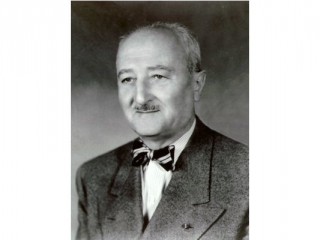
William Friedman biography
Date of birth : 1891-09-24
Date of death : 1969-11-12
Birthplace : Kishinev, Russia
Nationality : American
Category : Science and Technology
Last modified : 2011-12-21
Credited as : scientist, Cryptography pioneer, inventor
5 votes so far
William Friedman was born in Russia, and came to America with his family while he was still an infant. He studied genetics and worked in that field at Riverbank Laboratories, a predecessor of today's Alion Science and Technology. There he met and fell in love with his future wife, cryptanalyst Elizebeth Smith, and became drawn into her area of work. By the outbreak of the First World War, Friedman and his wife were among the nation's foremost cryptographers, and volunteered their codebreaking services to the war effort. After their work led to the arrest of 135 purported German spies in America who had been sending messages in encrypted Hindu, US military cryptographers were sent to Riverbank for classes taught by Mr and Mrs Friedman.
In 1918 Friedman joined the US Army and was assigned to France, where he helped break German coded communications during the last months of the war. He later served as personal translator to General John J. Pershing, and in 1929 he was installed as Director of a new super-secret unit of the Army, the Signal Intelligence Service. In this position he oversaw the decoding and translation of the Japanese diplomatic code (called the Purple Code) in 1940, and headed Operation Magic, the group of hundreds of military cryptographers that deciphered Japanese coded communications during World War II, providing crucial intelligence before the Battle of Midway.
The work of Friedman and his wife laid the foundation for the present-day US National Security Agency, and when the NSA was established in 1952, Friedman was its first Chief of Cryptography. For many years, the Friedmans' children and acquaintances were told only that he worked for the Army. The immense pressure of being in charge of US codebreaking during WWII and the subsequent Cold War caused Friedman to suffer at least two nervous breakdowns.
He invented several machines used in codebreaking, but was prohibited for reasons of national security from filing patents. After retiring in 1955 he was allowed to patent three of these devices, and received a lump payment of $100K from the federal government as compensation for six additional inventions on which patents remained prohibited. In retirement, he returned for special (and still classified) NSA assignments, but was critical of the Agency, and expressed concern that it was unnecessarily investigating the communications of ordinary citizens. In 1958, NSA agents raided the Friedmans' home and seized certain papers, the nature of which remains secret. He died in 1969.
Author of books:
-The Index of Coincidence and Its Applications in Cryptography (1922)
-Six Lectures on Cryptology (1963, essays)
-The Shakespearean Ciphers Examined (1957, non-fiction; with Elizebeth Friedman)
















